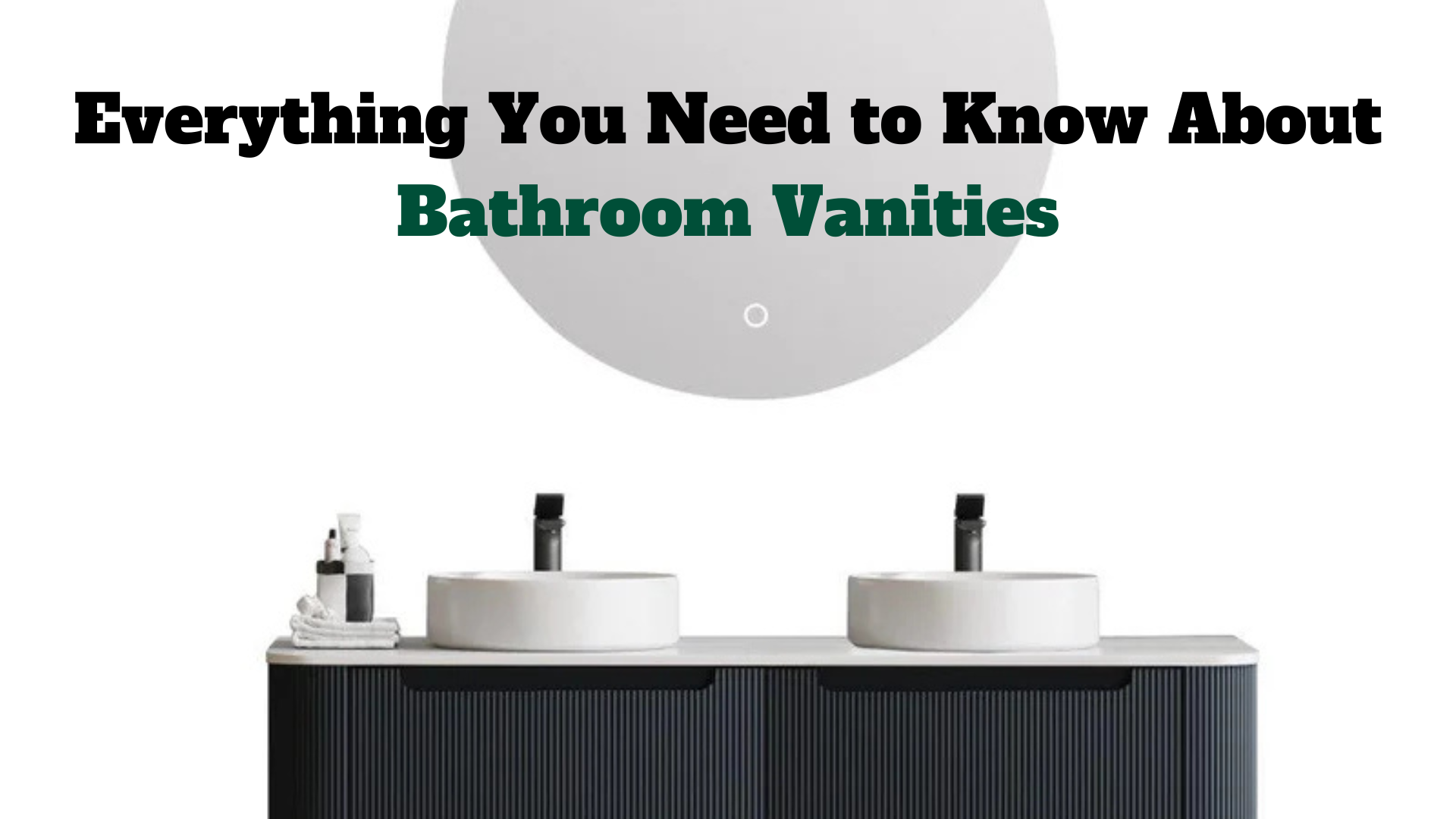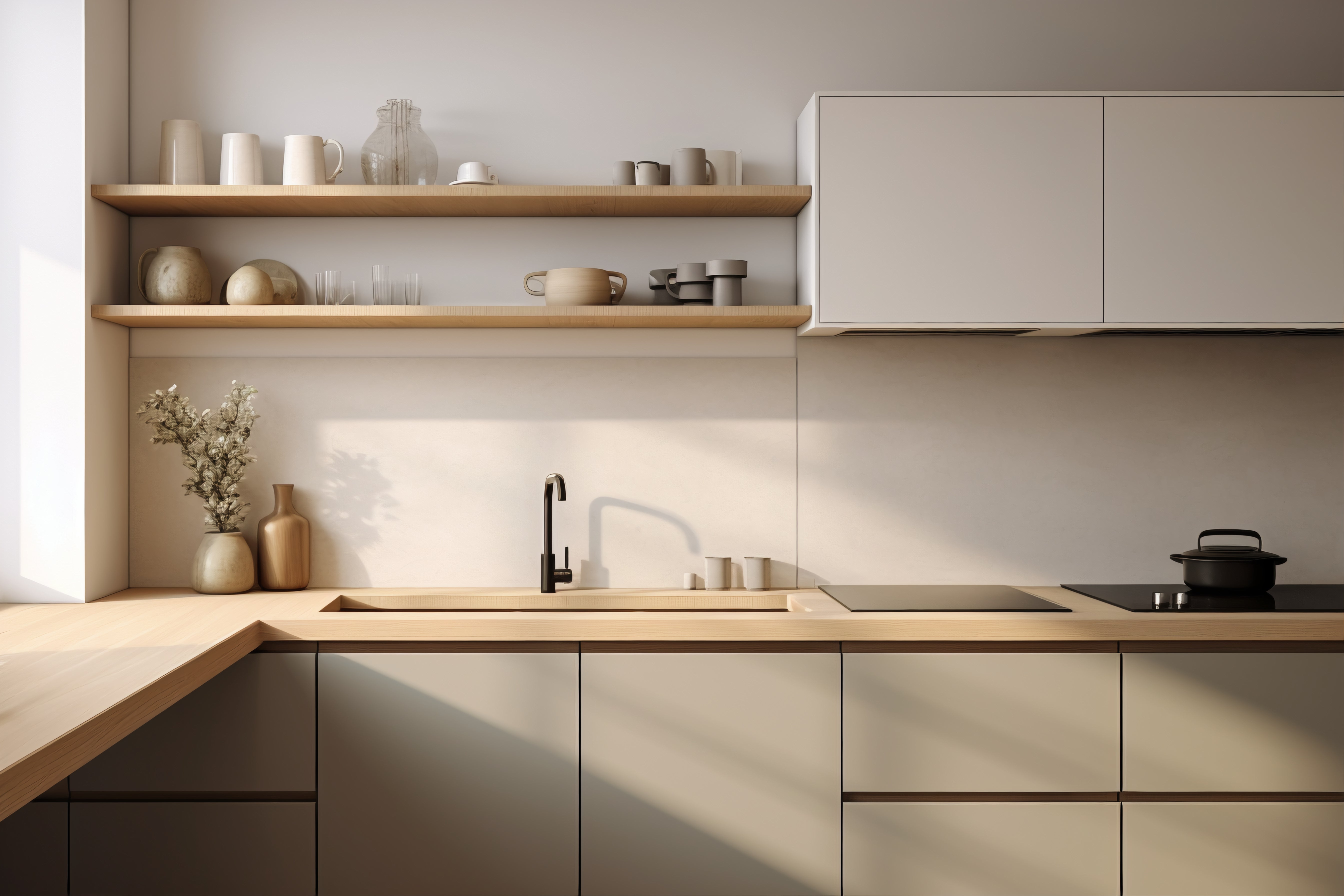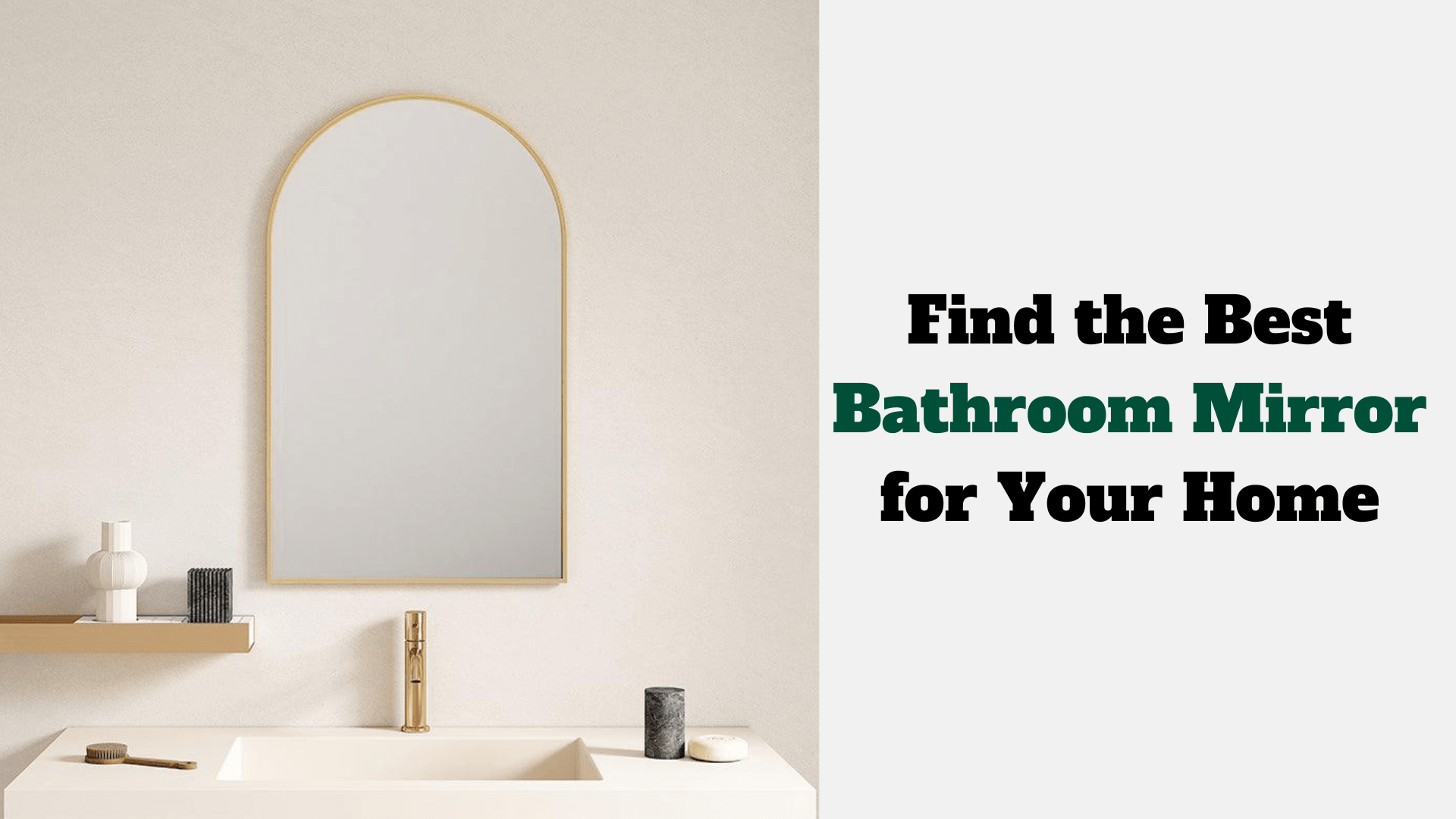Article: Everything You Need to Know About Bathroom Vanities

Everything You Need to Know About Bathroom Vanities
A bathroom vanity is more than just a piece of furniture—it’s a key part of your bathroom’s style and functionality. Whether you’re getting ready in the morning or winding down at night, the right vanity can make your daily routines smoother and your bathroom more beautiful. From sleek wall-mounted designs to practical freestanding options, there’s a perfect vanity for every space and need.
But choosing the right one isn’t always easy. With so many types, styles, and materials available, it’s important to know what to look for. In this blog, we’ll guide you through everything you need to know about bathroom vanities. From understanding the different types to learning how to maintain them, we’ve got you covered. Whether you’re remodeling or just upgrading, this guide will help you make the best choice for your home. Let’s dive in!
What is a Bathroom Vanity?
A bathroom vanity is a multi-purpose piece of furniture that combines a sink, countertop, and storage space. It serves as a central part of your bathroom, providing both functionality and style. At its core, a vanity helps keep your bathroom organized by offering storage for toiletries, cleaning supplies, or even extra towels. It also provides a surface for daily activities like brushing teeth, applying makeup, or washing your hands.
Vanities come in various shapes and sizes to suit different bathroom layouts. Some are compact and designed for small bathrooms, while others are large and feature double sinks for shared spaces. The key components of a vanity include:
- Base: This is the cabinet or structure that supports the sink and countertop.
- Countertop: The top surface, often made of materials like marble, quartz, or laminate, is where the sink sits.
- Sink: The basin that holds water for your daily needs.
- Storage: Drawers or cabinets built into the base for storing items.
A bathroom vanity not only improves functionality but also enhances the overall look of your bathroom. Choosing the right one can transform your space into a stylish and organized haven.
Factors to Consider When Choosing a Bathroom Vanity
Selecting the perfect bathroom vanity requires careful thought. Here are some factors to keep in mind:
-
Space and Layout
Measure your bathroom before buying a vanity. Make sure it fits without overcrowding the space. For small bathrooms, narrow or wall-hung vanities can save space. In larger bathrooms, you can opt for a freestanding or double-sink vanity. -
Style and Design
Your vanity should match the overall design of your bathroom. Modern bathrooms often feature minimalist wall-hung vanities, while traditional ones may include freestanding styles with decorative details. -
Material and Durability
Since bathrooms are prone to moisture, choose materials that are water-resistant. Popular options include wood with waterproof coatings, MDF (Medium Density Fiberboard), and stone countertops. -
Storage Needs
Consider what you need to store. If you have many items, a tallboy or vanity with extra drawers might be ideal. For minimal storage, a narrow vanity works best. -
Budget
Set a budget before shopping. There are options for every price range, from affordable MDF designs to luxurious marble-topped vanities.
Types of Bathroom Vanities
Bathroom vanities come in a wide range of styles and designs, each catering to different needs and preferences. Whether you have a small powder room or a spacious family bathroom, there’s a vanity type that’s perfect for your space. Here’s a closer look at the most popular options:
Wall-Hung Vanities
Wall-hung vanities, also known as floating vanities, are mounted directly onto the wall, leaving the floor beneath them open. These vanities are ideal for modern, minimalist bathrooms as they create a sleek and clean look. By freeing up floor space, wall-hung vanities make smaller bathrooms feel more spacious while making it easier to clean underneath. However, since they rely on wall support, they require proper installation and may not offer as much storage as other types.

Freestanding Vanities
Freestanding vanities are the most traditional and versatile option. These vanities rest directly on the floor and come in a variety of sizes and designs, from classic to contemporary styles. They offer plenty of storage with built-in cabinets and drawers, making them suitable for larger bathrooms or shared spaces. Freestanding vanities are easy to install and can blend seamlessly with most bathroom designs. However, they can take up more floor space, which might not be ideal for smaller bathrooms.

Narrow Vanities
Narrow vanities are designed for compact bathrooms or tight spaces where every inch matters. These slim units provide basic functionality without overwhelming the room. Although they have limited storage capacity, they are perfect for powder rooms or guest bathrooms where only minimal items need to be stored. Despite their smaller size, narrow vanities come in various stylish designs to complement your bathroom’s aesthetic.
Vanity Tops
Vanity tops are pre-assembled units that include the countertop and sink in one piece. These vanities are convenient and easy to install, making them a great choice for those looking for a hassle-free option. They come in a variety of materials, such as quartz, marble, or ceramic, offering both style and durability. However, since they are pre-designed, there is less room for customization compared to vanities where the sink and countertop are chosen separately.
Tallboy Vanities
Tallboy vanities are tall, vertical units that maximize storage space in bathrooms. They are ideal for organizing towels, toiletries, and other essentials, making them perfect for family bathrooms or homes with limited storage. While they provide excellent functionality, their height and bulk might not be suitable for smaller bathrooms, as they can make the space feel crowded.
Choosing the right vanity depends on your bathroom's size, design, and storage needs. With so many options available, you can find one that combines style and practicality to enhance your space.
Materials Used in Bathroom Vanities
Bathroom vanities are made from different materials, each offering unique benefits. Here’s a simple guide to help you understand the most common options:
- Solid Wood
- Durable and strong, solid wood is a premium choice.
- Requires proper sealing to prevent water damage.
- Gives a natural and timeless look to your bathroom.
- MDF (Medium Density Fiberboard)
- A budget-friendly alternative to solid wood.
- Resistant to warping and cracking.
- Comes in various finishes, including painted or laminated styles.
- Laminate
- Affordable and easy to clean.
- Available in a wide range of colors and patterns.
- Less durable compared to wood or stone.
- Stone (Marble, Quartz, Granite)
- Stone countertops add a luxurious and elegant touch.
- Highly durable and water-resistant.
- Requires proper maintenance to prevent stains.
- Ceramic and Porcelain
- Commonly used for sink materials or vanity tops.
- Easy to clean and resistant to water.
- Affordable and versatile in design.
When choosing materials, think about your budget, style preference, and how much maintenance you’re willing to do. Durable, water-resistant materials are ideal for ensuring your vanity lasts for years.
How to Choose the Right Bathroom Vanity
Choosing the right bathroom vanity can feel overwhelming with so many options available, but it doesn’t have to be. The key is to balance functionality with style while considering your specific needs. First, start by measuring your bathroom space. A vanity that is too large can make the bathroom feel cramped, while one that is too small may not provide enough storage. For smaller bathrooms, a wall-hung or narrow vanity can create a spacious look. In larger bathrooms, freestanding or double-sink vanities can provide more room and functionality.
Next, think about your storage needs. If you have a lot of toiletries, towels, or cleaning supplies, opt for a vanity with extra drawers, cabinets, or even a tallboy. For guest bathrooms or powder rooms, where minimal storage is required, a simple vanity top or narrow vanity works well.
Material is another important factor. Since bathrooms are high-moisture areas, choose durable and water-resistant materials like solid wood, MDF, or stone for your vanity. The countertop material should also be easy to clean and maintain. Consider options like quartz or granite for a luxurious yet practical choice.
Finally, consider the overall design of your bathroom. Modern bathrooms often pair well with sleek, wall-hung vanities, while traditional ones may look better with freestanding designs. By keeping your space, style, and storage needs in mind, you’ll find a vanity that not only looks great but also makes your daily routines easier.
Maintenance Tips for Bathroom Vanities
Keeping your bathroom vanity in good condition is essential to ensure its durability and appearance. Regular maintenance can help prevent wear and tear caused by moisture, spills, and daily use. Start by cleaning the surface of your vanity with a soft cloth and mild soap. Avoid using abrasive cleaners or scrubbing pads, as they can damage the finish. For countertops made of stone, use a specialized cleaner to maintain their shine and prevent staining.
Ensure that any water spills around the sink are wiped up immediately to prevent water damage or warping. Check for leaks under the sink regularly, as these can cause long-term damage to the vanity and surrounding area. If your vanity is made of wood, consider applying a waterproof sealant to protect it from humidity.
Lastly, organize the storage space within the vanity to avoid overloading drawers or cabinets. Proper organization reduces clutter and makes it easier to access your essentials. By following these simple steps, you can keep your bathroom vanity looking and functioning like new for years.
Why a Bathroom Vanity is a Worthy Investment
A bathroom vanity is not just another piece of furniture; it’s an essential feature that adds both practicality and style to your bathroom. It provides a central space for daily activities like washing, grooming, and storing essentials, making your bathroom more organized and functional.
A well-chosen vanity can significantly enhance the overall aesthetics of your bathroom. Whether you prefer a modern, minimalist design or a traditional, elegant look, the right vanity can tie the entire space together. It also increases the value of your home, as an updated and stylish bathroom is a key selling point for potential buyers.
Moreover, investing in a quality vanity ensures durability and long-term use. Materials like solid wood, quartz, or marble are built to withstand the challenges of a high-moisture environment. With proper care, a good vanity can last for many years, making it a cost-effective addition to your home.
Ultimately, a bathroom vanity is not just about storage or functionality. It’s a reflection of your style and a key element that transforms your bathroom into a comfortable and attractive space.
FAQs About Bathroom Vanities
-
What is the standard height of a bathroom vanity?
The standard height for a bathroom vanity is typically 32 to 36 inches. However, you can choose a height that suits your needs, especially if the vanity will be used by children or taller individuals. -
How do I choose the right size vanity for my bathroom?
Measure the available space in your bathroom and ensure the vanity leaves enough room for movement. Consider the placement of doors, windows, and plumbing fixtures to avoid obstructions. For smaller bathrooms, opt for narrow or wall-hung vanities. -
What materials are best for bathroom vanities?
Durable and water-resistant materials like solid wood, MDF (medium-density fiberboard), and stainless steel are ideal for the vanity body. For countertops, materials like quartz, granite, or solid surface are excellent choices due to their durability and easy maintenance. -
Can I install a bathroom vanity myself?
Yes, you can install a bathroom vanity if you have basic plumbing and carpentry skills. However, for complex installations involving wall-hung vanities or plumbing adjustments, it’s recommended to hire a professional for the best results. -
How do I maintain my bathroom vanity?
Regularly clean the vanity with a soft cloth and mild soap. Avoid abrasive cleaners that can damage the finish. Wipe up water spills promptly to prevent warping or stains, and periodically check for leaks under the sink to avoid long-term damage.



